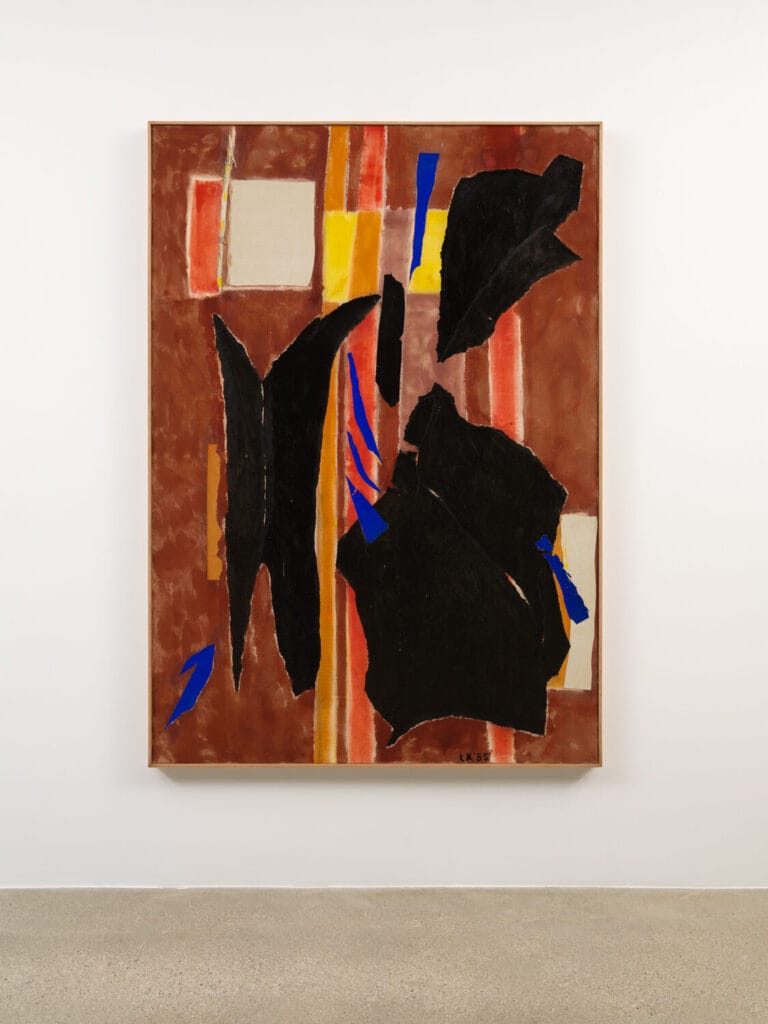“I am never free of the past. I have made it crystal clear that I believe the past is a part of the present which becomes part of the future.”
Lee Krasner[January 5, 2023; Long Beach, CA] Carolyn Campagna Kleefeld Contemporary Art Museum presents Lee Krasner: A Through Line from February 7–May 19. The exhibition provides a context to explore important abstract paintings and collages from the 1940s to the early 1960s. The exhibition includes four of the five Krasner works held in the Museum’s Gordon F. Hampton Collection and rarely exhibited works on loan. A Through Line specifically highlights breakthrough moments in her career spurred on by her practice of revisiting ideas over time. The artist leveraged exemplary marks, spatial strategies, and recurring themes in her pursuit of illusionistic gestural abstraction.
A Through Line begins with an exploration of Krasner’s early interest in cubism and her desire to develop purely abstract painting that appears dimensional without the illusory techniques of representational painting. Influenced by Pablo Picasso, Henri Matisse, and Hans Hofmann, her work in the 1930s and 1940s set the stage for her transformation in the 1950s and 1960s. We invite Museum visitors to study Krasner’s untitled work from 1942. It hangs alongside Pablo Picasso’s 1926 print, Scène d’intérieur, and Hans Hofmann’s painting Pure Space (1952) which has not been exhibited since its creation. These three works illustrate shared interests in exploring depth of field, linework, and different modes of geometric and gestural abstraction. Pure Space offers visitors to the exhibition an opportunity to better understand how Hans Hofmann theory of “push and pull” was translated into paint. As the exhibition continues, Krasner’s works demonstrate the continuing influence of Picasso, Matisse, and Hofmann.
From Krasner’s early cubist painting, visitors continue toward the center of A Through Line. Her poorly received 1951 exhibition at Betty Parsons Gallery is a main event in her career after which she hit a sustained stride that would cement her reputation. The Museum is pleased to present one of two paintings which survive from this Parsons exhibition. On loan from Kasmin Gallery New York, the breathtaking Number 2 (1951) will be on view for the third time in its history and, seventy-one years later, only the second time in the United States ever. Number 2 survived destruction by Krasner. She used most of the paintings from Parsons for collage scrap or underpaintings for later works presented in 1955.

Following her adventure with Betty Parsons, it appears that Krasner did not work for at least a year. In 1953 she began anew. On loan from Des Moines Art Center, Black and White (1953) is a collage incorporating scraps from her own work and from works by her husband Jackson Pollock. The collage illustrates a key step toward new works the artist debuted in a 1955 exhibition at the Stable Gallery. This exhibition is now recognized as historic highlight not only for Krasner, but for American abstract painting. The result of Krasner’s creative reuse was later described as “one of the great events of the decade” by art critic Clement Greenburg. On view from this exhibition is an iconic work from the Museum’s collection. Stretched Yellow (1955), which is painted atop a 1951 painting exhibited at Parsons, is critical to understanding how Krasner’s early work leads up to 1955 and to what happens after. Experiencing both works in the same gallery clarifies how Krasner’s cycles of revision helped drive her progress toward creating spatially complex gestural abstractions.
While the exhibition unfolds chronologically, the works defy linear models of time. Later works on view, including Cornucopia (1958) and What Beast Must I Adore? (1961) illustrate how Krasner continued to revisit gesture, illusory depth, and line and shape in new ways while remaining grounded in an embrace of pure abstraction and a familiar creative language. A Through Line demonstrates Krasner’s independent vision and stylistic hallmarks. The works included in this exhibition prove Krasner was not only resilient and dedicated, but also visionary. In illustrating a continuity Krasner’s critics sometimes denied she had, the Museum disputes critiques of Krasner that are often gender biased. Today, Krasner is a revered artist whose importance to the history of art is finally garnering deserved recognition. With A Through Line, we recognize that Lee Krasner helped shape the course of art history and assert that she will continue to inspire the next generation.
Carolyn Campagna Kleefeld Contemporary Art Museum
1250 N Bellflower Blvd, Long Beach, CA 90840
